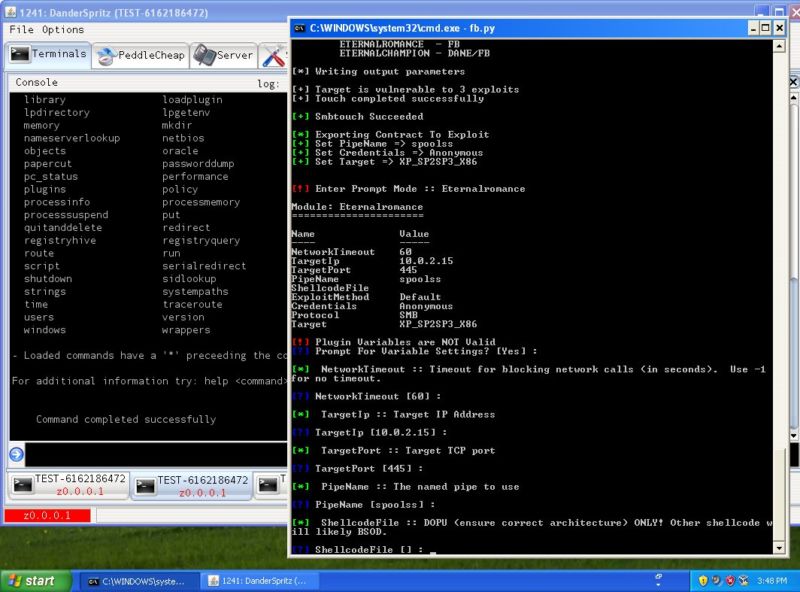
The people behind Tuesday's massive malware NotPetya outbreak might have had access to two National Security Agency-developed exploits several weeks before they were published on the Internet, according to clues researchers from antivirus F-Secure found in some of its code.
EternalBlue and EternalRomance, as the two exploits were codenamed, were two of more than a dozen hacking tools leaked on April 14 by an as-yet unknown group calling itself the Shadow Brokers. Almost immediately, blackhat and grayhat hackers used EternalBlue to compromise large numbers of computers running out-of-date versions of Microsoft Windows. Within a week or two, blackhats started using EternalBlue to install cryptomining malware. No one really noticed until the outbreak of the WannaCry ransomware worm on May 12, which infected an estimated 727,000 computers in 90 countries.
On Thursday, F-Secure researchers said that unconfirmed timestamps left in some of the NotPetya malware code suggested that the developers may have had access to EternalBlue and EternalRomance as early as February, when they finished work on the malware component that interacted with the stolen NSA exploits. The potential timeline is all the more significant considering the quality of the component, which proved surprisingly adept in spreading the malware from computer to computer inside infected networks. The elegance lay in the way the component combined the NSA exploits with three off-the-shelf tools including Mimikatz, PSExec, and WMIC. The result: NotPetya could infect both patched and unpatched computers quickly. Code that complex and effective likely required weeks of development and testing prior to completion.
Fully baked
"February is many weeks before the exploits EternalBlue and EternalRomance (both of which this module utilizes) were released to the public (in April) by the Shadow Brokers," F-Secure researcher Andy Patel wrote in a blog post. "And those exploits fit this component like a glove."
Whereas the two other main components of NotPetya—an encryption component and a component for attacking a computer's master boot record—were "pretty shoddy and seem kinda cobbled together," Patel said the spreading component seems "very sophisticated and well-tested." It remains possible that the February timestamps found in some of the code was falsified. Assuming the stamps are correct, they suggest that developers may have had access, or at least knowledge of, the NSA exploits by then. By contrast, Patel added:
WannaCry clearly picked [the NSA] exploits up after the Shadow Brokers dumped them into the public domain in April. Also WannaCry didn't do the best job at implementing these exploits correctly.By comparison, this "Petya" looks well-implemented, and seems to have seen plenty of testing. It's fully-baked.
The weeks leading up to the possible February completion of the NotPetya spreader was a particularly critical time for computer security. A month earlier, the Shadow Brokers advertised an auction that revealed some of the names of the exploits they had, including EternalBlue. NSA officials responded by warning Microsoft of the theft so that the company could patch the underlying vulnerabilities. In February, Microsoft abruptly cancelled that month's Patch Tuesday. The unprecedented move was all the more odd because exploit code for an unpatched Windows 10 flaw was already in the wild, and Microsoft gave no explanation for the cancellation.
"Meanwhile, 'friends of the Shadow Brokers' were busy finishing up development of a rather nifty network propagation component, utilising these exploits," Patel wrote.
When Patch Tuesday resumed in March, Microsoft released a critical security update that fixed EternalBlue. As the WCry outbreak would later demonstrate, large numbers of computers—mainly running Windows 7—failed to install the updates, allowing the worm to spread widely.
If the timeline is correct, it might mean the NotPetya developers had some sort of tie to the Shadow Brokers, possibly as customers, colleagues, acquaintances, or friends. It might also make NotPetya the first piece of in-the-wild malware that had known early access to the NSA exploits. Patel didn't speculate how the NotPetya developers might have gotten hold of EternalBlue and EternalRomance prior to their public release in April.
A grimmer picture
Shadow Brokers first appeared in August when the group claimed it hacked NSA developers and released a cache of purported hacking tools. A day later, researchers from antivirus provider Kaspersky Lab said digital fingerprints left in some of the leaked code proved the tools belonged to "Equation Group," the name corresponding to the NSA's elite hacking group formally known as Tailored Access Operations.
Early speculation was that Shadow Brokers members acquired a small number of hacking tools that NSA personnel stored on one or more staging servers used to carry out operations. The volume and sensitivity of the exploits and documents released over the next several months slowly painted a much grimmer picture. It's now clear that the group has capitalised on what is likely the worst breach in NSA history. There's no indication that the agency has identified how it lost control of such a large collection of advanced tools or that it knows much at all about the Shadow Brokers' membership. The group, meanwhile, continues to publish blog posts written in deliberately broken English, with the most recent one appearing on Wednesday.
The F-Secure theory adds a new, unsettling entry to the Shadow Brokers' resume. The world already knew the group presided over a breach of unprecedented scope and leaked exploits to the world. Now, we know it also provided crucial private assistance in developing one of the most virulent worms in recent memory.














Hello, Thank you for your meaningful words which is easily understand by people,it would really helpful for the proper workflow. Thankyou for sharing this wonderful article , We are also sharing the blogs on the topic of Gaming software which is helpful for playing games on pc if you want to read it then kindly visit here Dolphin Emulator
ReplyDelete